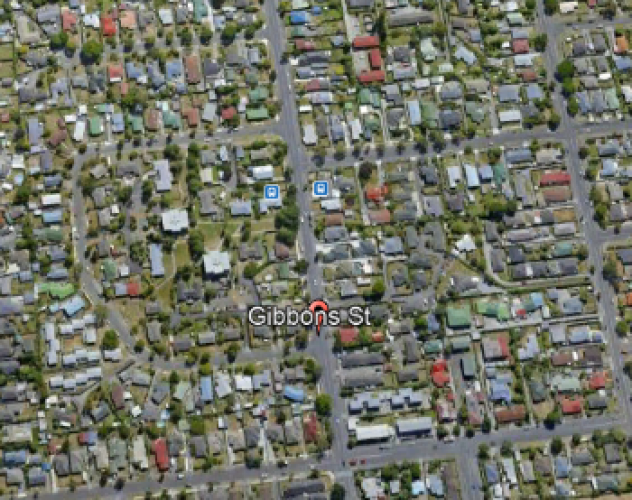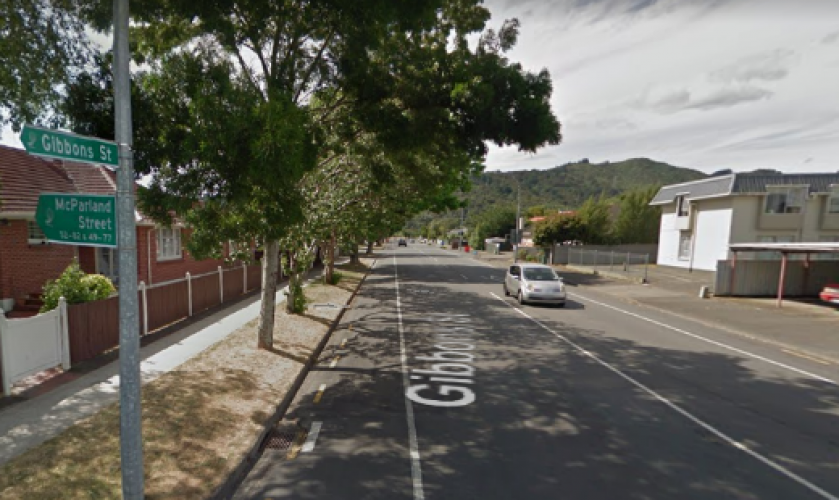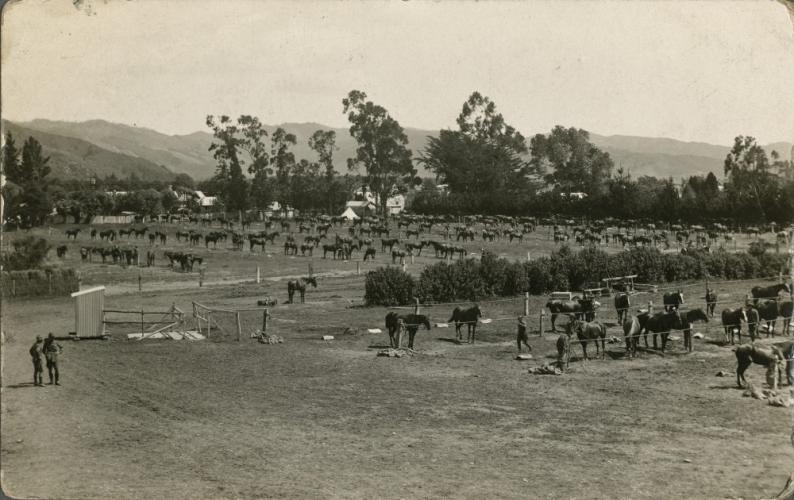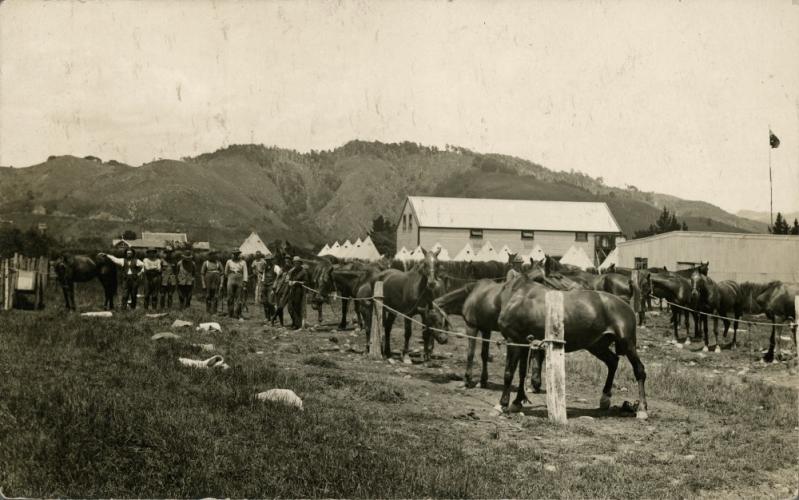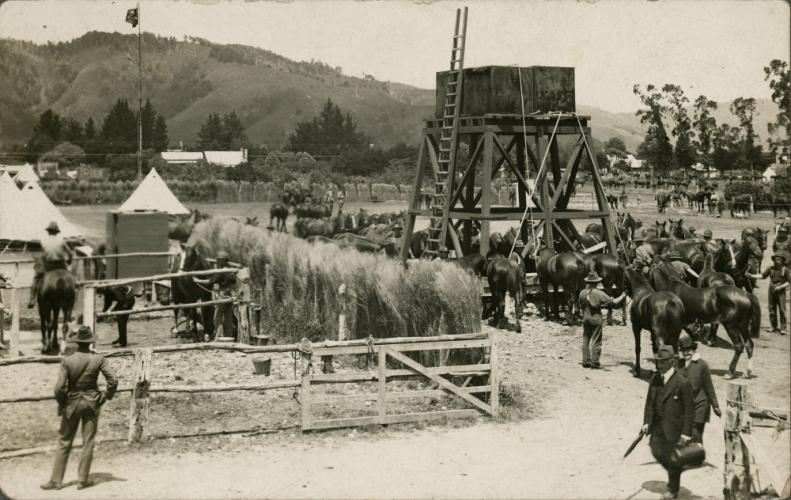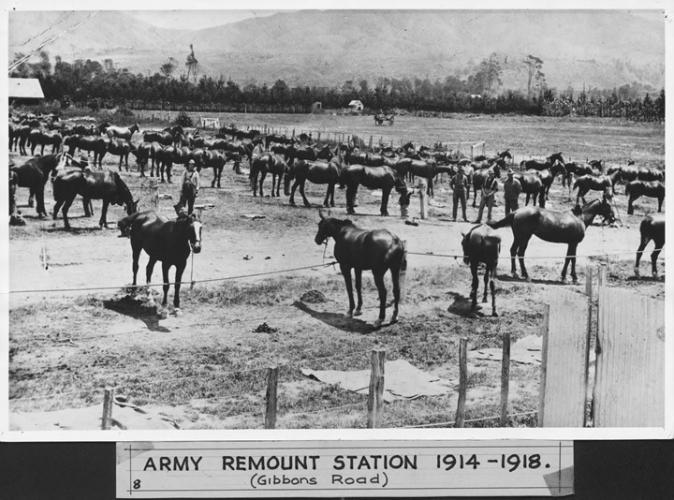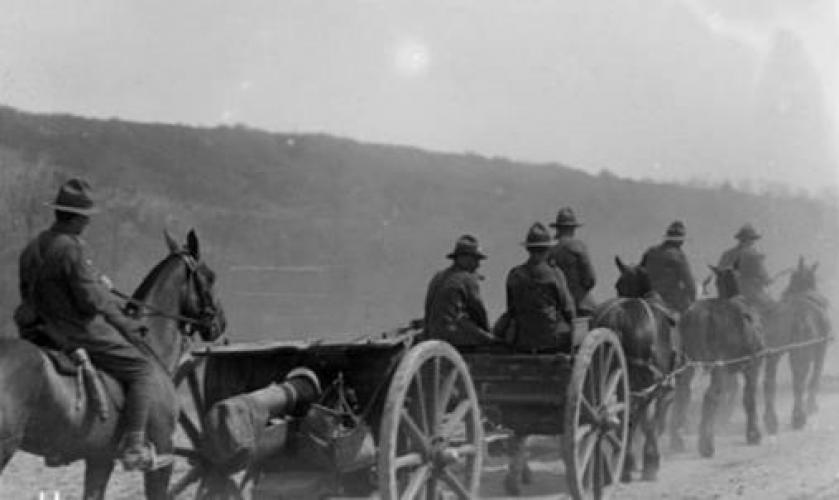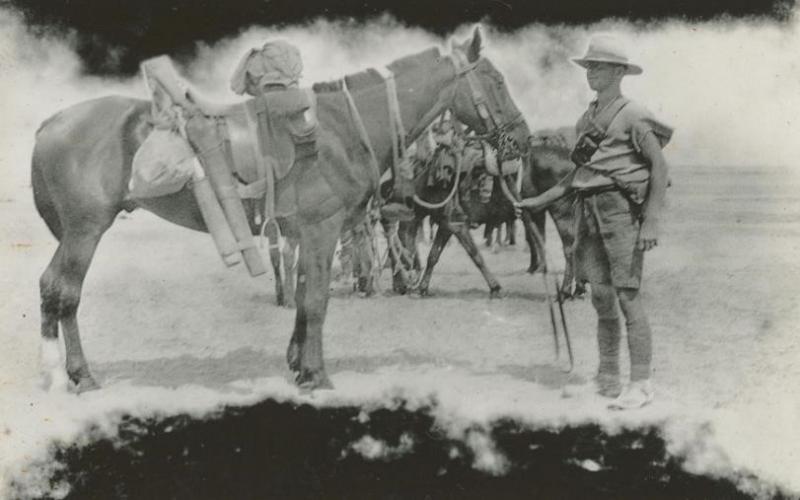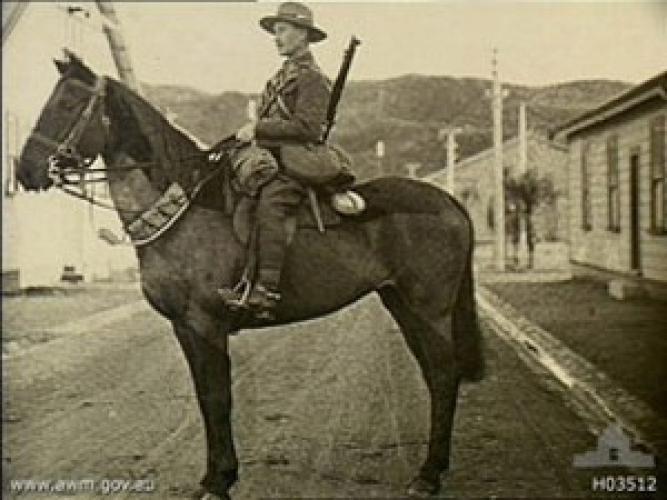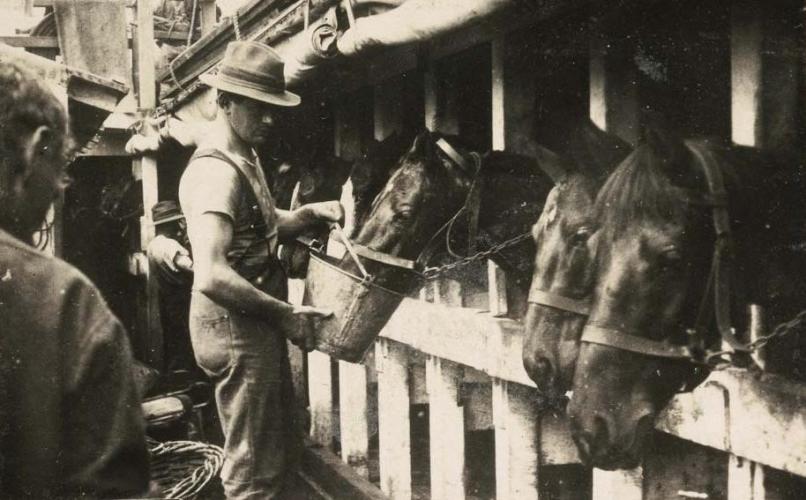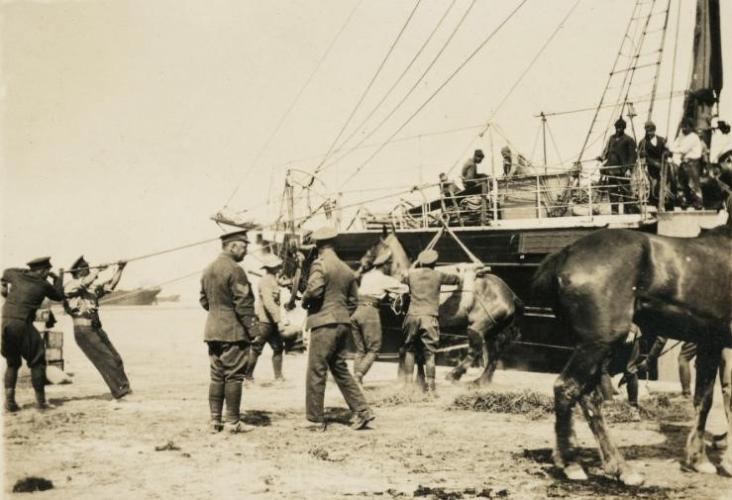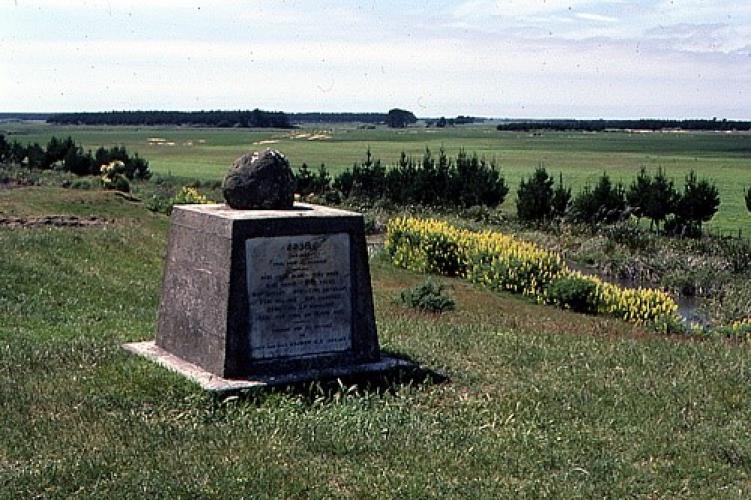212 Gibbons Street Remount Depot UH, street view 2019 looking towards Hutt River
Reason for the name
This poppy place was named in honour of all the horses that were taken overseas in World War 1. Gibbon Street Remount Depot was a military camp site dedicated to the care, well-being, training and supply of horses. Upper Hutt has rich and diverse links with our military service overseas.
In 1914 there were 400,000 horses in New Zealand, which were used on farms and to transport people and goods in cities. Between 1914 and 1916 the government acquired over 10,000 of these horses to equip its forces in the First World War.
Horses were vital to the Army. Not only did the Mounted Rifles require them for transport but the artillery guns, limbers as well as the myriad of waggons all required horses to move them. Upon mobilisation the Army immediately had a need for horses of all descriptions and capabilities. They were classified as light and heavy draught horses for the artillery and supply waggons, mounted chargers, pack and general troop horses. To supply these animals government stock inspectors of the Department of Agriculture throughout the country began to inspect and purchase them on behalf of the Army. The average prices paid was £17 ($2,600 in 2018 value) for a riding horse and £24 (3,600 in 2018 value) for an artillery or transport horse.
Author: The Poppy Places Trust, Historian Howard Weddell and Wayne Myers UH RSA
The Remount Depot
When Trentham was appointed as the training Camp the horses were dispatched to Upper Hutt to be close to Wellington for shipping overseas with the troop convoys. An area on the outskirts of the Upper Hutt Township was leased on Gibbon Street. The area was well drained, close to the Hutt River to ensure plenty of water and close to the railway station.
Once in the Remount Depot the horses had a further veterinary check and when accepted were marked as Army property. This was done by branding the Defence mark (N↑Z) on one of the fore hoofs and the horse’s registration number of the other fore hoof. The animals were maintained by a group of soldiers, primarily from the Veterinary Corps, and civilian employees. The horses were exercised, and if further training or conditioning was required a programme was set for each horse. A veterinary hospital was established to cater for the more minor injuries or ailments of the horses.
At one time in excess of 1,000 horses were administered by the Remount Depot which consisted of horse lines, hay and fodder stacks, dung piles, feed and water troughs and camp living facilities for the men, all within 15 acres of land. This area was also used for the administration and training of the animals and most were paddocked throughout the valley wherever there was sufficient grazing and the land could be leased. The requirement for grazing did put some pressure on farms and pastures as far north as Kaitoke and the Mangaroa Valley and south to Stokes Valley. Additional hay and grain for fodder were transported by rail from the Wairarapa and the Manawatu areas. To undertake these activities the peak strength of the Depot was 100 men.
Both the Camp and Remount Depot were fortunate as they were a short distance from the Government State Laboratory at Wallaceville, which during the war became known as the Wallaceville Veterinary Quarantine Station. Here an equine segregation facility was established to deal with infectious illnesses such as strangles and mud fever and the veterinary specialists were on call to inspect and treat horses that were suspected of needing advanced veterinary care.
The transportation of horses from all over the country to the Depot and the subsequent issuing of horses to various camps placed a considerable strain on the Upper Hutt Railway Station and the adjacent cattle yards as this was the principle means of transporting the animals. In the course of the war the Army purchased 9,347 animals and the majority of these passed through the Gibbon Road Remount Depot before embarking at the Wellington wharf.
In late 1916 the Army ceased shipping horses overseas due to shortage of horse transport ships and the NZEF overseas obtained horses from the British Army. The Remount Depot downsized and combined with the Wallaceville Veterinary Station. In April 1918 the whole Remount function was transferred to Tauherenikau Camp, close to Featherston Camp where the soldiers selected for the Mounted Brigade reinforcements were being trained with horses. After the armistice in 1918 the remaining horses were sold for a profit.
Civilian grooms were employed by the Defence Department and attached to the Remount Depot along with other enlisted Service personnel. For the large number of horses held at the depot during the early war years there would have been a number of personnel required to assist with the care and training of these horses. Lynly Yates compiled the following list of 54 names from various sources:
ADAMSON Frank 1890-1970 Sapper 4/1023 JOHNSON William E unknown unknown
ALLEN William unknown First Reserves KEARNEY William 1890-1949 Trooper 17/386
AVISON Frank 1871-1944 Trooper 13543 KEIGHTLEY R Cook Rifleman 60342
BATCHELOR Leslie James 1888-1947 Lance Corporal 46426 LITTLE John Lewis 1891-1970 Trooper 17/396
BOWKER George 1878-1925 Corporal 19/370 LOGAN William John Unknown First Reserves
BROUGHAM Charles Roy 1896-1968 First Reserves MANSILL George Edward 1863-1937 Rifleman 26124
BULLOT Eugene Isadore 1873-1941 Second Reserves MARSHALL Thomas 1888-1915 Corporal
CALDER Horace Frederick 1890-1944 Trooper 17/324 MARCUSEN Peter 1877-1943 Sergeant 17/308
CATOR William Duncan 1861-1944 Civilian Cook MEACHEM Percy Samuel 1894-1970 Driver 2/679
COSTELLO T unknown unknown MONCRIEFF HGT Plimmer unknown First Reserves
CUNEEN John Edward 1897-1967 Sapper 4/1762 MORRISON Henry unknown First Reserves
DANAGHY Len J unknown Orderly Vet Corps MORROW George unknown unknown
EDWARDS Alva 1888-unknown Trooper 17/301 MURPHY John Conway unknown unknown
ELWORTHY Herbert 1878-1948 Lieutenant MURPHY Patrick 1877-1953 Trooper 17/389
EMERY Arnold Arthur 1867-unknown Private 12535 MACDONALD John unknown First Reserves
FERGUSON unknown unknown MCLEAN G 1917 Head Farrier remount
FULLER Ernest 1890-1958 Coy Serg Major MCPHEE H C unknown unknown
GALLIGAN James 1887-unknown Trooper 17/327 O’DEA Edmond 1890-1936 Rifleman 74361
GENT Leonard 1886-1967 First Reserves PHILPOT Edward Charles 1988-1975 Trooper 17/393
GIBBONS James ploughman Reservists Private 79211 POTTER H unknown unknown
GREEN Samuel Percy unknown Second Reserves RAPLEY Wallace Garnet 1898-1947 Private 66541
GRONN Lawrenz 1893-1969 Second Reserves REID Seddon 1895-1918 † Rifleman 22686
HEWSON Leonard Charles 1884-1952 Second Reserves RITCHIE unknown unknown
HORAN Thomas Martin 1884-1946 First Reserves TILLEY Reginald Charles 1873-1962 Major
JEFFRIES J or JEFFS unknown unknown TOCKER H unknown unknown
JEFFRIES W or JEFFS unknown unknown WALSH J D unknown unknown
JOHNSON William E unknown unknown WEBBY Ross 1889-1934 Private 49855
WESTERN Richard James 1866-1917 † Lance Corporal 17/331
Further details about the Remount Depot:
Arrangement to establish a Remount Depot in Upper Hutt began when Colonel Reakes of the Defence Department Veterinary Services arranged to rent a large paddock in Gibbons Street from Mr H C Gibbons. The rental from October 1914 to January 1915 was £75. Additional land was required including a shed at the entrance to the paddock and a two storey wooden shed and the Defence Department agreed to pay Mr Gibbons additional rent. All horses brought into Trentham Camp by men for the reinforcements were ordered to hand them over to the Officer in charge of the Remount Camp. By January 1915 Mr R C Tilley later promoted to Lieutenant then Captain was in charge of the Remount Depot.
Arrangements were made with Mr Pringle of Silverstream to use 35 acres of grazing land for 4 months at the cost of £10 per month. Mr Donald Reid’s paddocks were also used for grazing. Mr Brown who owned a number of sections around Upper Hutt gave permission for the use of his land at no cost. Unfortunately some men camped on an additional piece of land (lots 26 & 27 in King Street) not owned by Mr Brown and the owners claimed rent from the Defence Department for its use.
The depot employed civilian grooms’ who collected horse hair which was sold along with a few horses that had to be destroyed and the money was approved to be used for the comfort of the men during the winter months. The groom accommodation was tents but in June 1915 arrangements were made to supply wooden floors for twelve of the tents. The Health department proposed the building of latrine accommodation and cook house. Owing to the wet state of the camp the blacksmiths were unable to shoe horses so a request was made for a farriers shed to be built. Mr Harrisons tender of £25 10s 0d was accepted.
A message from Captain R C Tilley regarding Troops required for Remount depot: an Officer, two NCO and twenty men to assist with horses on and after Monday 06 November 1916
Telegram –Camp Commandant Trentham. Please issue instructions for a Medical Officer to inspect proposed temporary Canvas Camp site at Remount Depot Upper Hutt where approximately 30 men will be accommodated temporary until approximately middle December stop. Please report if medical officer approves of site and arrangements stop. Grant facilities for issue of necessary tents and cooking utensils requisitioned for by Remount Officer for this camp - 04 November 1916 Please detail one Office Two Non Commissioned Officers and twenty men to report to the Remount Officer Upper Hutt on Tuesday Seventh Instant to look after horses in the depot stop. The men to be selected from 19th Mounted Rifles or from details preferably the latter in order not to interfere with Mounted Training stop. These personnel will be required at Remount depot until approximately middle December stop. They will be quartered and rationed at Remount depot stop. Please notify Remount Officer actual time of arrival.
06 December 1916 letter. Although 450 horses were despatched from the Remount Depot at Upper Hutt there yet remains upwards of a 100 horses. Until such time as we can make arrangement for their disposal I should like the assistance of two NCO and twenty men and shall be glad if you will arrange for this number to be retained from those at present at the depot or if these are removed that they be replaced by others before their removal signed Lt Col A R Young ADVS Wellington Military district
02 October 1917 – In view of the fact that there appears little likelihood of further shipments of horses being made I recommend that notice be given to the owner of the present Remount depot property of the intention of the Department to terminate its tenancy. I can do this if given authority. Also that steps be taken to establish a small depot at or near Trentham Camp. We are leasing a paddock at Upper Hutt adjacent to the river and it is advisable to retain this meanwhile as it may be of value in connection with the new depot, a site for which I had in mind and though I am certain regarding it until I make further inquiries. Colonel D J Reakes
To H C Gibbons - It has been decided to remove the Remount Depot from the Upper Hutt, and re-established it on the Wallaceville Laboratory Farm. I have therefore to intimate to you that the land and premises at the Upper Hutt now occupied as a Remount depot also the whole of the land rented for paddocking purposes will not be required after 30 November next – 16 October 1917
Conference re purchasing of additional land adjoining Tauherenikau four section camp so that the Remount depot at Wallaceville to be abandoned and moved Remount Depot to Tauherenikau – 27 February 1918. Remount Depot Wallaceville – Defence Department horses are running on Government Farm at Wallaceville. Water supplied by wind mill which is at present out of order local plumber failed to get it right Private Mansill was in Trentham camp and former plumber at Upper Hutt understands the windmill and able to repair it. Request that Private Mansill be transferred to Captain Tilley of Remount Depot - 05th February 1918 (they also had a pig farm on the land)
Problems with Chains, Leather headstalls and halters for use in Remount Depot Upper Hutt
The life of a rope halter does not exceed one month under the best conditions. With horse given to chewing halters, several may be used in a week. Leather headstalls are estimated to last twelve months. For the greater safety in securing horses by chains must be taken into account. Horses were biting through their halters and getting free and have been badly kicked as a result. Problems have been found with the care of horses, in both the training and at the Remount Camps. The horses have the habit of chewing through the rope halters and get away through the halters slipping off their heads. Proper leather headstalls and chains to tie up with were recommended but none have arrived from England and are not available in New Zealand.
Some difficulty is being experienced in connection with head ropes for horses and they are gradually being replaced by light chains at small cost. It is found no matter how the ropes are treated whether with tar or soft soap the horses chew them. Owing to the shortage of material in the New Zealand and supplies not arriving from overseas we shall continue with the ordinary head ropes that will suffice until the arrival of troops in Egypt where a better opportunity to procure suitable chains.
Bess - the lucky horse
Some 10,000 New Zealand horses went overseas to serve in the First World War. Some were packhorses, many of which helped on the Western Front. Bess was among the several thousand riding horses that served with New Zealand’s mounted forces in Sinai and Palestine, and were much loved by their riders. Bess was lucky to survive – she survived the dangers of being transported, and the high risk of being killed in action or dying of disease in the Middle East. She had to put up with poor feed, little water and extremes of heat and cold. Bess was the only horse from the Middle East to return home to New Zealand – and only three other horses returned from the Western Front.
Each volunteer mounted rifleman was supposed to bring a horse, and they were bought by government and issued back to the soldier if the horse was deemed suitable. The horses had to be aged 4–7, 14–15.2 hands in height, strong and not too light a colour. Stallions were not allowed and geldings were preferred. ‘NZ’ was branded on one hoof, their number on another hoof. In addition, more than 1000 horses were donated to the government.
Bess
One of these ‘gift’ horses was a four-year-old black thoroughbred. Bred by A. D. McMaster of Matawhero, near Martinborough, in 1910, she was by Sarazen out of Miss Jury. She was known as F. A. Deller's ‘Zelma’ prior to being presented to the New Zealand Army. ‘Zelma’ was allocated to the Wellington Mounted Rifles Regiment and selected by Captain Charles Guy Powles, who renamed her Bess.
Powles had previously served in the South African War. An officer in New Zealand’s Staff Corps at the outbreak of the First World War, he became brigade major to the New Zealand Mounted Rifles Brigade (NZMR). He served with the NZMR in multiple campaigns during the war, becoming commanding officer of the Canterbury Mounted Rifles and ending the war as a lieutenant colonel. He wrote two books on the NZMR, including: The New Zealanders in Sinai and Palestine with Major A. Wilkie (1922) and History of the Canterbury Mounted Rifles 1914–1919 (1928).
From New Zealand to Egypt
Bess and Powles left New Zealand with the main body of the New Zealand Expeditionary Force in October 1914, bound for Egypt along with 3815 horses. The horses were transported in rows of cramped stalls, some exposed to the weather. The men had to groom them, rub their legs to prevent swelling, and exercise them daily on coconut matting on the deck. About 3% of the horses died while being transported and their bodies were thrown overboard.
Nearly all of the 10,000 horses went initially to Egypt. More than half were riding horses, like Bess, used by the troops and officers. Nearly 4000 were draught horses or packhorses used for artillery and transport purposes. Many of these ended up on the Western Front. Very few horses were used at Gallipoli, so most, including Bess, remained in Egypt during 1915. From late 1915 the horses were reunited with their men as they returned from Gallipoli.
New Zealand Mounted Rifles
Bess remained in the Middle East along with several thousand other New Zealand horses. They were assigned to the New Zealand Mounted Rifles Brigade which, as part of the ANZAC (Australian and New Zealand Army Corps) Mounted Division with Australian Light Horse brigades and Royal Horse Artillery batteries, served in the Sinai Campaign of 1916 and the Palestine campaign of 1917–18.
Riding horses were used throughout by the mounted troops. The men were not cavalry, fighting from their horses. Rather, the horses allowed the riflemen to move rapidly to new positions. The men operated in groups of four and, when they dismounted to take part in actions like infantry, one man would be left behind to look after the horses.
Conditions in Sinai and Palestine
The conditions on the ground in both the Sinai and Palestine were physically trying for the horses. They carried heavy loads – a fully loaded horse carried about 130 kilograms – including rider, weapons, two bandoliers of ammunition, forage, blankets, food and water. They had to travel long distances on difficult terrain, putting up with ticks, fleas and biting flies, shortages of food and water, and challenging weather – from extreme heat, burning sand and blinding dust, to cold nights and driving rain.
Inevitably horses lost condition. Some died, others were too weak to continue and were evacuated to hospital. In 1917, immediately before the Battle at Ayun Kara, some horses went without water for up to 72 hours. Horses also died as a result of wounds from enemy artillery fire or aerial attacks. The men became emotionally and physically dependent on their horses – and often used their shadows to get protection from the midday sun.
Conditions on the Western Front
Conditions were no better for horses on the Western Front. Food, water or suitable shelter were in short supply, and during winter they suffered because of the wetness and mud. Sometimes horses were killed or wounded by shell fire or aerial bombing in rear areas where they were tethered or stabled together.
What happened to the horses?
It is unclear exactly how many New Zealand horses survived to the end of the war. Records suggest some ‘original’ horses were still with their units. Bess was one such horse. Shortly before the Palestine campaign ended Powles and Bess joined the New Zealand Division in France. After France, she served with Powles during the occupation of Germany’s Rhineland. At the end of the war an acute shortage of transport, and quarantine restrictions related to animal diseases prevalent overseas, prevented most horses from returning to New Zealand.
Horses serving in Egypt were pooled with other British army horses. The fittest were initially kept but most were not. Those fit for work were sold locally, while those deemed unfit were killed. Some men tried to have their horses deemed unfit, rather than have them sold locally, concerned that the locals would mistreat them. A few of the horses on the Western Front were eventually repatriated to England.
Bess was one of just four horses originally from New Zealand that were subsequently transported home. All had belonged to officers associated with General Sir Alexander Russell: Beautiful to the late Captain Richard Riddiford, Dolly to General Sir Alexander Russell, Nigger to the late Lieutenant Colonel George King and Bess to Powles. The horses were repatriated to England in March 1919 and subjected to 12 months quarantine. Bess apparently took part in a victory parade in Britain. The horses arrived back in New Zealand in July 1920.
Later life
After the war Bess was the model for the sculpture of a wounded New Zealand horse on a memorial to the Anzac mounted troops at Port Said in Egypt. That statue was destroyed in the 1956 Suez crisis, and copies were made and erected at Albany in Western Australia and in Canberra.
Bess continued to serve Powles on her return to New Zealand in 1920 while he was a commander at Trentham and later as headmaster at Flock House, an agricultural training school for dependants of war veterans. Bess produced several foals, and died on land close to Flock House in 1934. Powles buried her at Flock House and erected a memorial. The square-shaped memorial, topped by a large rock, features two memorial plaques. One denotes the places where Bess served during and after the war. The other bears an Arabic inscription that translates as ‘In the Name of the Most High God’.


